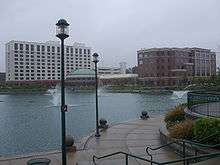Joint Base Langley–Eustis
Joint Base Langley–Eustis | |
|---|---|
|
Part of Air Combat Command (ACC) U. S. Army Installation Management Command | |
| adjacent to Newport News, Virginia | |
|
A U.S. Air Force F-22A Raptor flies over Fort Monroe, Virginia in 2005 | |
|
U.S. Army soldiers on parade at Fort Eustis, Virginia in 2011 | |
 JB Langley–Eustis Location of Joint Base Langley–Eustis, Virginia | |
| Coordinates |
37°04′58″N 076°21′38″W / 37.08278°N 76.36056°W (Air Base) 37°09′33″N 076°34′30″W / 37.15917°N 76.57500°W (Army Fort) |
| Site information | |
| Controlled by |
|
| Site history | |
| Built | 1916 |
| In use | 1916–present |
| Garrison information | |
| Garrison |
|
| Airfield information | |||||||||||
|---|---|---|---|---|---|---|---|---|---|---|---|
| IATA: LFI – ICAO: KLFI – FAA LID: LFI | |||||||||||
| Summary | |||||||||||
| Elevation AMSL | 11 ft / 3 m | ||||||||||
| Website | www.jble.af.mil | ||||||||||
| Runways | |||||||||||
| |||||||||||
Joint Base Langley–Eustis (IATA: LFI, ICAO: KLFI, FAA LID: LFI) is a United States military facility located adjacent to Hampton and Newport News, Virginia. The base is an amalgamation of the United States Air Force's Langley Air Force Base and the United States Army's Fort Eustis which were merged on 1 October 2010. The base was established in accordance with congressional legislation implementing the recommendations of the 2005 Base Realignment and Closure Commission. The legislation ordered the consolidation of the two facilities which were nearby, but separate military installations, into a single Joint Base, one of 12 formed in the United States as a result of the law.
Unlike other joint bases that share common perimeters, the two components are geographically separated by 17 miles. In January 2010, the Air Force reactivated the 633d Air Base Wing to assume host unit and installation support functions at each location.[3] The installation assumed its full operational capability (FOC) in October 2010.[4] The 633rd ABW commander is Col. John Allen, Jr., with Chief Master Sgt. Trae King as its command chief master sergeant. The 633rd ABW is responsible to Air Combat Command.
Langley
Langley units
To accomplish their mission, the support unit men and women of the 633d Air Base Wing at Langley are housed in the Mission Support Groups and Medical Group and support several tenant units:[3]
- The 1st Fighter Wing is composed of the 1st Operations Group and the 1st Maintenance Group, which work together to maintain Joint Base Langley–Eustis' F-22 Raptors.
Operational squadrons of the 1st Operations Group are: (Tail Code: FF)
- 27th Fighter Squadron (F-22 Raptor)
- 94th Fighter Squadron (F-22 Raptor)
- The 480th ISR Wing operates and maintains the Air Force Distributed Common Ground System, or DCGS, also known as the "Sentinel" weapon system, conducting imagery, cryptologic, and measurement and signatures intelligence activities.
The Wing is composed of the following units worldwide:
- 480th ISR Group, Fort Gordon, Ga.
- 497th ISR Group, Joint Base Langley-Eustis, Va.
- 548th ISR Group, Beale Air Force Base, Calif.
- 692d ISR Group, Joint Base Pearl Harbor-Hickam, Hawaii
- 693d ISR Group, Ramstein Air Base, Germany
- 694th ISR Group, Osan Air Base, South Korea
- The 192d Fighter Wing mission is to fly and maintain the F-22 Raptor at Joint Base Langley-Eustis through the 149th Fighter Squadron, and support the ongoing intelligence mission through the 192d Intelligence Squadron.
- The 633rd ABW is an Air Force-led mission support wing, serving both Air Force and Army units, as a result of a congressionally mandated joint-basing initiative between Langley and Eustis.
Langley also hosts the Global Cyberspace Integration Center field operating agency and Headquarters Air Combat Command (ACC).
Langley is also home to the F-22 Raptor Demo Team. This team, who travels all over the world performing different maneuvers used in air combat, is used to help recruit for the United States Air Force. Performing in airshows and other special events all around the world, the squadron is the only demonstration team in the world to use the F-22 Raptor.
Major Commands to which assigned
- Air Combat Command, 2010 – Present[5]
Major historical units
- 1st Fighter Wing, 2010–Present (F-22A)
- 633d Air Base Wing, 7 January 2010 – Present (Installation support)[5][6][7]
Fort Eustis

Fort Eustis, a historic Army installation and the second half of Joint Base Langley–Eustis, is an area to train service members in transportation, aviation maintenance, logistics and deployment doctrine with its diverse landscape and easy access to the James River.
The installation is the training ground for the majority of the transportation MOSs (with the exception of the 88M truck driver specialty located at Fort Leonard Wood, Mo.) and all of the helicopter maintenance technicians. It is the home of the Transportation Regiment, and received the transfer of some activities that were conducted at Fort Monroe, which was decommissioned on September 15, 2011 under BRAC.[8]
References
![]() This article incorporates public domain material from the Air Force Historical Research Agency website http://www.afhra.af.mil/.
This article incorporates public domain material from the Air Force Historical Research Agency website http://www.afhra.af.mil/.
- ↑ Langley Air Force Base, official site
- ↑ FAA Airport Master Record for LFI (Form 5010 PDF), effective 2008-06-05
- 1 2 Joint Base Langley–Eustis Units
- ↑ Public Affairs: Joint Base Langley-Eustis
- 1 2 Active Air Force Bases Within the United States of America on 17 September 1982 USAF Reference Series, Office of Air Force History, United States Air Force, Washington, D.C., 1989
- ↑ Maurer Maurer, Air Force Combat Units Of World War II, Office of Air Force History, 1983
- ↑ Endicott, Judy G., USAF Active Flying, Space, and Missile Squadrons as of 1 October 1995. Office of Air Force History
- ↑ Fort Eustis homepage - official site
External links
| Wikimedia Commons has media related to Langley Air Force Base. |
- FAA Airport Diagram (PDF), effective December 8, 2016
- FAA Terminal Procedures for LFI, effective December 8, 2016
- Resources for this U.S. military airport:
- FAA airport information for LFI
- AirNav airport information for KLFI
- ASN accident history for LFI
- NOAA/NWS latest weather observations
- SkyVector aeronautical chart for KLFI
- 1st Fighter Wing fact sheet
- 1st Operations Group fact sheet
- http://www.yellowcabofnewportnews.com
- 633d Force Support Squadron.
- The Peninsula Warrior, unofficial Joint Base Langley–Eustis newspaper




